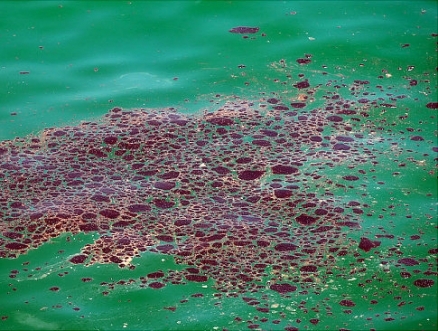Natural oil degradation processes
From The Encyclopedia of Earth
(Redirected from Recover naturally)
September 3, 2010, 12:00 am
October 9, 2011, 9:16 pm
Natural processes that may act to reduce the severity of an oil spill (Weathering)or accelerate the decomposition of spilled oilare always at work in the aquatic environment. These natural processes include weathering, evaporation, oxidation, biodegradation, and emulsification.
- Weatheringis a series of chemical and physical changes that cause spilled oilto break down and become heavier than water. Winds, waves, and currentsmay result in naturaldispersion, breaking a slick into droplets which are then distributed throughout the water. These droplets may also result in the creation of a secondary slick or thin film on the surface of the water.
- Evaporationoccurs when the lighter substances within the oilmixture become vapors and leave the surface of the water. This process leaves behind the heavier components of the oil, which may undergo further weatheringor may sink to the ocean floor. For example, spill (Oil spill)sof lighter refined petroleum-based products such as kerosene and gasoline contain a high proportion of flammable components known aslight ends. These may evaporatecompletely within a few hours, thereby reducing the toxiceffects to the environment. Heavier [[oil]s]leave a thicker, more viscous residue, which may have serious physical and chemical impacts on the environment. Wind, waves, and currentsincrease both evaporationand natural dispersion.
- Oxidationoccurs when oilcontacts the waterand oxygen combines with the oilto produce water-soluble compounds. This process affects oil slicks mostly around their edges. Thick slicks may only partially oxidize, formingtar balls. These dense, sticky, black spheres may linger in the environment, and can collect in the sediments of slow moving streamsor lakes (Origin and age of lakes)or wash up on shorelines long after a spill (Oil spill).
- Biodegradationoccurs when micro-organisms such as bacteria feed on oil. A wide range of micro-organisms is required for a significant reduction of the oil. To sustain biodegradation, nutrients such as nitrogenand phosphorus are sometimes added to the waterto encourage the micro-organisms to grow and reproduce. Biodegradation tends to work best in warm water environments.
- Emulsificationis a process that formsemulsionsconsisting of a mixture of small droplets of oiland water. Emulsions are formed by wave action, and greatly hamper weathering and cleanup processes. Two types of emulsions exist: water-in-oil and oil-in-water. Water-in-oil emulsions are frequently called "chocolate mousse," and they are formed when strong currentsor wave action causes water to become trapped inside viscous oil. Chocolate mousse emulsions may linger in the environment for months or even years. Oiland water emulsions cause oilto sink and disappear from the surface, which give the false impression that it is gone and the threat to the environment has ended.
